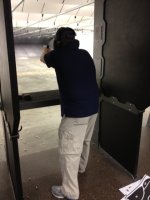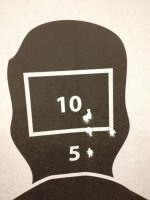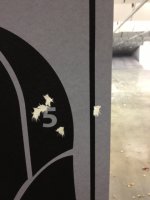Hi Coach. Need some advice please.
I'm a lefty, new shooter. I seem to consistently shoot low and right, and am trying to address my issue.
Based on what I've read, I am "overgripping" the pistol, but I am not real sure what "overgripping" means.
The ammo I am using is PMC Bronze 115 gr FMJ. The pistol is a rental S&W M&P FS in 9mm. I have shot 1,235 rounds over the last 6 months or so (same pistol, same ammo).
I'm trying to use a consistent, balanced "nose over toes" stance.
My grip is pretty high, as high as I can get. My thumbs generally are pointed downrange. I extend about as far as is comfortable, and I don't use a death grip, but enough grip in my shooting (left) hand to control the sight. I shoot at silhouette targets at about 7 yards at our local range, Shooter's World in Tampa.
A picture of me shooting is in picture one, for reference.
I usually shoot in groups of five, slowly, and try to focus firmly on the front sight, squeeze the trigger and wait for the bang. But what usually happens is that all my rounds will land low and right. They will group ok, but almost all groups are low and right.
The second picture shows a typical group, low and right.
Lately I have been wondering, "is it the gun" and I've lurked enough on the board to be pretty sure, you know, "it's not the gun". .
.
But I've never really, been able to pin-point what I am doing wrong.
Now, as an experiment, on one of my last groups this weekend, I REALLY tried to SLOWWWWW Way down and allow the shot to break 'whenever' it happened. I remember, I was kind of surprised, when a shot took place, in this group. When I looked up, this group was the first time, EVER, that I started putting rounds at or around the center of the target i.e. where I was aiming.)
This is the last picture.
So, I must have done something, on that last group, because I was astonished that I was able to do that, and finally, I was firing and landing, on the center of the target (more or less; the last round I was so excited I was landing near where I aimed, that I forgot. That is the one out there at 3 o'clock lol.)
So my question is, is it only the fact that I was so focused, so determined not to move the front site off the target, that I was drawing the trigger straight back and not somehow twisting the gun low and right as I shot, in the last second? Or is there something else I did right in this last group that resulted in better accuracy?
And what is "overgripping" anyway?
The Mrs. and I just moved to Tampa, so I don't know a lot of folks to ask locally just yet who can help me with this at the range.
I have however, learned the folks on this forum are some of the most experienced shooters I've ever seen, so I thought I would turn to ya'll and get some feedback on what was going on.
Any advice gratefully accepted.
Much obliged.
Rich
I'm a lefty, new shooter. I seem to consistently shoot low and right, and am trying to address my issue.
Based on what I've read, I am "overgripping" the pistol, but I am not real sure what "overgripping" means.
The ammo I am using is PMC Bronze 115 gr FMJ. The pistol is a rental S&W M&P FS in 9mm. I have shot 1,235 rounds over the last 6 months or so (same pistol, same ammo).
I'm trying to use a consistent, balanced "nose over toes" stance.
My grip is pretty high, as high as I can get. My thumbs generally are pointed downrange. I extend about as far as is comfortable, and I don't use a death grip, but enough grip in my shooting (left) hand to control the sight. I shoot at silhouette targets at about 7 yards at our local range, Shooter's World in Tampa.
A picture of me shooting is in picture one, for reference.
I usually shoot in groups of five, slowly, and try to focus firmly on the front sight, squeeze the trigger and wait for the bang. But what usually happens is that all my rounds will land low and right. They will group ok, but almost all groups are low and right.
The second picture shows a typical group, low and right.
Lately I have been wondering, "is it the gun" and I've lurked enough on the board to be pretty sure, you know, "it's not the gun".
But I've never really, been able to pin-point what I am doing wrong.
Now, as an experiment, on one of my last groups this weekend, I REALLY tried to SLOWWWWW Way down and allow the shot to break 'whenever' it happened. I remember, I was kind of surprised, when a shot took place, in this group. When I looked up, this group was the first time, EVER, that I started putting rounds at or around the center of the target i.e. where I was aiming.)
This is the last picture.
So, I must have done something, on that last group, because I was astonished that I was able to do that, and finally, I was firing and landing, on the center of the target (more or less; the last round I was so excited I was landing near where I aimed, that I forgot. That is the one out there at 3 o'clock lol.)
So my question is, is it only the fact that I was so focused, so determined not to move the front site off the target, that I was drawing the trigger straight back and not somehow twisting the gun low and right as I shot, in the last second? Or is there something else I did right in this last group that resulted in better accuracy?
And what is "overgripping" anyway?
The Mrs. and I just moved to Tampa, so I don't know a lot of folks to ask locally just yet who can help me with this at the range.
I have however, learned the folks on this forum are some of the most experienced shooters I've ever seen, so I thought I would turn to ya'll and get some feedback on what was going on.
Any advice gratefully accepted.
Much obliged.
Rich




![correction_chart[1].jpg](https://cdn.smith-wessonforum.com/attachments/100/100691-6f5f4dc43598e1d4a5f60867e0120a98.jpg?hash=Y4u_0-Qvyl)





